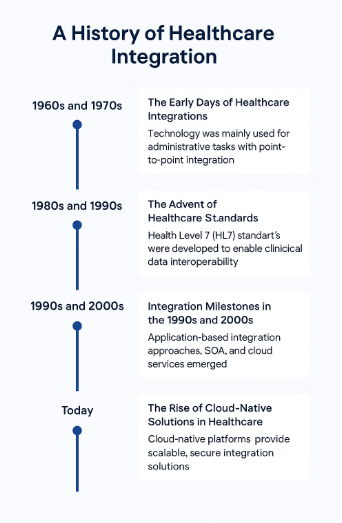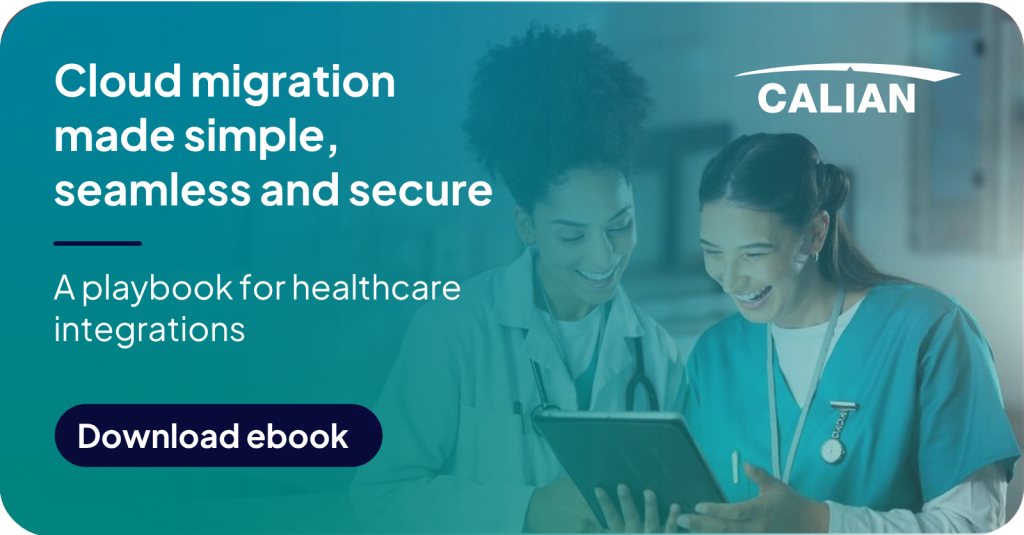The healthcare industry is in the midst of a digital revolution, with cloud-native solutions redefining how care is delivered and operations are managed to drive better patient outcomes. While system integration in healthcare began long before the advent of cloud technology, decades of evolving data strategies and infrastructure have paved the way for the cloud-first innovations we see today.
From early point-to-point interfaces to modern platforms like Corolar Cloud, healthcare integrations have made remarkable strides. These advancements have not only improved efficiency and interoperability but also equipped organizations to meet the growing demands of a complex, fast-changing ecosystem.
In this blog, we’ll explore the evolution of healthcare integrations—tracing their history, highlighting key milestones, and looking ahead to how cloud solutions are shaping the future of connected, data-driven healthcare.
The Early Days of Healthcare Integrations
The origins of healthcare IT began in the 1960s and 1980s when technology was primarily limited to administrative tasks, such as billing and scheduling. At this time, integration was rudimentary, relying on point-to-point interfaces that directly connected one system to another. Although these early systems fulfilled their initial purpose, they were neither scalable nor flexible enough to manage the intricate demands of clinical data.
The Advent of Healthcare Standards
By the 1980s and 1990s, the healthcare industry began to recognize the importance of standardization in data exchange. This led to the creation of Health Level 7 (HL7) standards, a pioneering framework for clinical data interoperability. HL7 introduced a common language, enabling disparate systems to work together more effectively. This was a monumental step forward, laying the groundwork for the structured data exchanges we see today.
Although these advancements marked progress, the systems of this era were complex to implement and demanded extensive custom coding for integration. This highlighted the need for a more flexible and scalable solution.
Integration Milestones in the 1990s and 2000s
The next wave of progress in healthcare integrations came with the introduction of application-based integration approaches in the late 1990s. Tools like Cloverleaf (1995) and eGate (1999) began simplifying connectivity between systems, giving rise to the “hub-and-spoke” integration model seen in products like IBM WebSphere (2001).
Service-Oriented Architecture (SOA) became the hallmark of the early 2000s, marking a shift toward modular and reusable services. This architecture allowed healthcare organizations to streamline operations, enabling smaller components of systems to communicate through standardized interfaces.
Alongside SOA, RESTful APIs entered the scene, simplifying integrations even further. With their ability to provide lightweight, flexible connections between applications, APIs became a significant driver for more modern integrations.
At the same time, healthcare organizations began exploring cloud services like Microsoft Azure and Amazon Web Services (AWS) to complement their on-premises systems. These infrastructures demonstrated the potential of scalable, secure, and cost-efficient platforms for handling burgeoning datasets.
While these methodologies provided a strong foundation, the emergence of cloud-native platforms would later prove to revolutionize healthcare infrastructure by delivering tailored solutions designed to address the unique demands of the industry.
Overcoming barriers to adoption
Leipsig and Brasnett discussed common barriers to implementing user-centric design and how to address them:
- Resistance to change: Recognizing that “humans are creatures of habit,” Brasnett recommends identifying change champions that can help demonstrate benefits to foster buy-in and ease transitions.
- Lack of user engagement: Involve team members early and allocate additional training and support resources to reduce strain and build enthusiasm. You can also drive internal momentum through quick wins, such as improvements in appointment workflows that immediately enhance experiences.
- No ‘one-size-fits-all’ solution: No single system can perfectly address the diverse needs of every organization, team or user. Strategic integrations that can adapt to evolving needs can provide flexibility while ensuring compliance with industry standards.
- Lack of data sharing agreements: Organizations must prioritize establishing robust frameworks that protect privacy while facilitating shared access to vital data to enable truly connected care. “Data doesn’t lie,” Brasnett said. “It provides clear insights into healthcare quality, resource allocation and patient care improvements.”
The Rise of Cloud-Native Solutions in Healthcare
Today, cloud-native integration platforms are at the forefront of innovation. Unlike legacy applications retrofitted for cloud hosting, these platforms are purpose-built for the cloud, leveraging its advanced capabilities to deliver unparalleled scalability, security, and performance.
Cloud-native platforms excel where traditional models fall short, offering easy adaptability to emerging technologies. These modern systems empower healthcare organizations to integrate data sources like wearables, remote monitoring devices, and external care providers seamlessly into their workflows. The result? Enhanced patient care and operational efficiency.

Corolar Cloud, for example, is a leading healthcare integration solution built to harness the power of Microsoft Azure services. By efficiently managing API calls per demand, flexing data storage, and ensuring enterprise-grade security, Corolar Cloud has set a new standard in data interoperability.
Key benefits of cloud-native healthcare integrations include:
- Scalability: Seamlessly expand computing resources on demand, eliminating the need for costly physical hardware investments and enabling future growth.
- Enhanced Security: Leverage industry-leading encryption protocols and ensure full compliance with stringent healthcare standards, including HIPAA, to safeguard sensitive patient data.
- Reliability: Benefit from exceptional uptime, guaranteeing uninterrupted access to critical patient information and ensuring operational continuity.
- Cost Efficiency: Transition from on-premise systems that require large-scale infrastructure investments to a flexible, pay-as-you-go model that scales with your needs. This approach optimizes resource allocation while reducing long-term operational costs as your organization continues to modernize.
As healthcare continues to evolve, cloud-native solutions are becoming indispensable for organizations aiming to remain competitive and agile in delivering high-quality patient care.
Transforming the Future of Healthcare
The evolution of healthcare integrations highlights a clear shift toward enhanced interoperability, streamlined efficiency, and smarter data utilization. Solutions like Corolar Cloud not only address the challenges of today but also lay the foundation for future breakthroughs in healthcare innovation.
The healthcare industry is always evolving, making it vital to stay on top of emerging trends. Understanding these changes helps organizations refine strategies, adopt new technologies, and deliver better patient care. At Calian Health, we see these key trends shaping the future of healthcare:
- Artificial Intelligence (AI) and Machine Learning (ML)
AI and ML are increasingly integrated with cloud-based platforms to analyze health data, develop predictive models, and improve clinical decision-making. These advancements rely on cloud infrastructures to support large-scale computational tasks.
- Real-Time Data Access
Real-time integration capabilities will enable instant access to critical patient information, such as medical histories, test results, and treatment plans. This supports seamless coordination between healthcare providers, ensuring timely decision-making, reducing errors, and improving overall patient care.
- Population Health Analytics
Cloud-native platforms will enable broader, regional analyses of health trends by aggregating and analyzing vast amounts of data from multiple sources in real time. This enhanced capability will help public health officials identify patterns, track emerging issues, and pinpoint opportunities for timely intervention to improve community health outcomes.
- Improved Interoperability
Refining APIs and standards like FHIR (Fast Healthcare Interoperability Resources) is key to improving data sharing between healthcare systems. These advancements enable seamless communication, streamline workflows, enhance patient care, and give providers more accurate, accessible information across platforms.
- Proactive Patient Engagement
By integrating data from wearables, patient portals, and scheduling systems, cloud-native integrations will provide patients with a seamless, centralized view of their health information and empower them to take a more proactive and informed role in managing their health.
The digital transformation of healthcare is driving a smarter, more interconnected future. By adopting agile, scalable, and innovative solutions, healthcare organizations are becoming better equipped to tackle patient care challenges and redefine industry standards.
How Corolar Cloud is Leading the Charge
Corolar Cloud empowers healthcare organizations with the agility, security, and reliability needed to thrive in today’s ever-evolving digital landscape. Designed specifically to address the unique challenges of the healthcare industry, Corolar enables you to meet the demands of cloud-based infrastructures with a structured and scalable approach that future-proofs your healthcare IT.
Why Corolar Cloud?
- Modernize with Cloud-Native Technology: Go beyond basic hosting and unlock the full potential of the cloud with a platform purpose-built for scalability, resilience, and automation. As a true cloud-native solution, Corolar Cloud enables faster innovation cycles, seamless updates, and rapid adoption of advanced technologies like AI and machine learning—driving smarter decisions, improved efficiency, and better patient outcomes.
- Accelerate time to value: Rapidly deploy new integrations using plug-and-play adapters that support key healthcare standards—reducing complexity, accelerating implementation, and enhancing patient care and operational efficiency.
- Built-In Security and Compliance: As a Microsoft Azure-native solution, Corolar Cloud delivers enterprise-grade security and compliance with healthcare regulations, ensuring patient data is protected at every stage.
- Scalable Deployment with Expert Support: Scale at your own pace and champion adoption with access to dedicated support, personalized training, and a migration strategy tailored to your organization’s needs.
- Improve Patient Outcomes Through Data Access: Enable better care coordination by eliminating data silos and providing real-time, interoperable access to complete patient information.
Conclusion
The move to cloud-based healthcare infrastructure is more than a technological upgrade— it marks a transformative opportunity to redefine how care is delivered. By embracing modern integration platforms, healthcare organizations can unlock greater efficiency, improve interoperability, and ultimately drive better patient outcomes.
The path to modernization starts with a clear understanding of your current systems and challenges. By partnering with experienced cloud technology providers, organizations can design a customized integration strategy that aligns with their goals and positions them for long-term success in an increasingly connected healthcare landscape.
Is your organization ready to embrace the next era of healthcare innovation? Connect with our experts today to discover how Corolar Cloud can future-proof your healthcare IT.
Plus, get your free copy of our playbook for healthcare integrations to help make your cloud migration journey simple, seamless, and secure.
